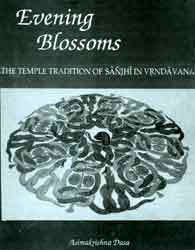
Dance and Divinity
Book Review – Evening Blossoms- The Temple Tradition of Sanjhi in Vrndavana’, is a publication in the `ksetra-sampada’ (cultural-heritage) series. This series is part of the Centre’s endeavour to study and document the culturally vibrant regions of India. Vraja is one such region that has been taken up. This book is the first in the series of four books of the `Vraja-Nathadvara-Prakalpa’ project, jointly undertaken by IGNCA and the Sri Chaitanya Prema Samsthana, Vrndavana.
Evening Blossoms is an elaborate account of the Sanjhi tradition of Vraja. This thorough study is done by the author Asima Krishna Dasa, who hails from New York, and has spent two decades watching the Sanjhi creations every year. `Sanjhi’ is a design created by flowers and powdered colours in the homes and temples of Vraja in the pitr-paksa (a period of a fortnight in autumn dedicated to performing srarddha (ritual rites for deceased ancestors).
The author has analyzed the word Sanjhi’ through all the disciplines and aspects viz, linguistic, etymologic, mythological, scriptural and historical, etc. Etymologically Sanjhi is connected to (i) Sanskrit Sajja(decoration), or Samdhya (evening) (ii) Hindi `Sajavat’ (decoration) or `Sanjha’ (evening) or Samaja (society).
Sanjhi has also been analyzed in the book in three broad cultural stages – the folk, the poetic and the temple. The tradition of Sanjhi its ritualistic aspect and its contemporary practice in the temples of R a d h a r a m a n a Radhavallabha and Radhamadhava of Vrndavana along with the temple of Ladlilala of Barsana have been discussed thoroughly in the monograph. The beauty of Sanjhi is brought alive by 58 plates, adorning the monograph.
The tradition of makingSanjhi in homes goes back to the era of Radha and Krishna, when the duo created Sanjhi , an ephemeral Goddess, every evening in this fortnight and worshipped her. God Sanjhi was also created and worshipped at this time. Radha and her friends collected flowers from the nearest forest for making Sanjhi and Sanjhi and Krishna would also join them as a `shyama-sakhi’ ( a lady-friend) in collecting the flowers and making of Sanjhi. “The rasa dance may be posited as the culmination of the rites associated with Sanjhi…”
Much preparation goes in for making Sanjhis. The cow dung of Kamdhenu (the celestial cow) was applied on a selected wall in the house and then, the design was created by sticking different varieties of flowers over it. The goddess Sanjhi and the God Sanjha used to be depicted herein.
The same would be effaced the next morning to create a fresh pattern in the evening. This is done all along this fortnight and the flowers used in creating these Sanjhis would be stored. Navaratra (the period of nine auspicious nights for making of images of Goddess Durga, who too is adorned, worshipped and finally immersed in the waters) follows the pitr-paksa, so the flowers would still be stored and finally immersed in sacred waters, after the Navratras. Sanjh’ “originally an evening worship performed by women, it has gained in status by being identified with trisamdhya”.
The spot for making Sanjhi slowly shifted from walls to floors from walls and the tradition reached temples from homes. Hence, the temple tradition of Sanjhi is the main focus of the author. Coloured stones, metal foils and pieces of mirror replaced flowers. Sanjhis were even made on water.
Nowadays, temple-Sanjhis have grown bigger in size and shape. The large temple Sanjhis are created by means of stencils and powdered colours. These designs depict the tale of Sanjhi and Sanjha. The author has meticulously and graphically described the matrix and dynamics of these large temple Sanjhis.
The mythology ascribes Sanjhi to Vedic mandala (diagram), which was created within the Agni-kunda (the fire-pit) constructed inside the Yajnasala (a sacrificial enclosure). It used to be decorated with auspicious symbols and floral designs. The vedi (altar) on which the ritual used to be performed was also decorated with such mandalas.
Both the designs made with coloured powders are indicative of the acquaintance of the Sanjhi was the Vedic-rituals. Bhagvata Purana and other medieval Bhakti poets mention the playing of Sanjhi in Vraja. Also, it is said to be “Symbolic the the worship of Radha and Krishna”… “At the time of worship they (the Sanjhis) are transformed from works of art fashioned by human beings into a divine being, Goddess Sanjhi “.
Dr. Kapila Vatsyayan has written an illuminating Foreword, in which she says “The making and obliteration of the image, whether on floor or mud as in the case of Sanjhi and other Kolam and of images which are finally immersed in the waters…. through the very act of ritual to beyond form and transform.” The other aspects of this rich traditional art come to light through an informative after word by Srivatsa Goswami.
Asimakrishna Dasa says, “In the course of writing about it (the Sanjhi), I have neglected to dwell on its beauty because that is something I could not recreate in words”.
– Book Reviewed by Dr. Sushma Zadoo
Evening Blossoms
The Temple Tradition of Sanjhi in Vrndavana By Asimakrishna Dasa
Published by IGNCA and Sterling Publishers Pvt. Ltd. 1996, pp 63, plates 58, Rs. 750 (HB)
[ Newsletter | List of Newsletter ]




